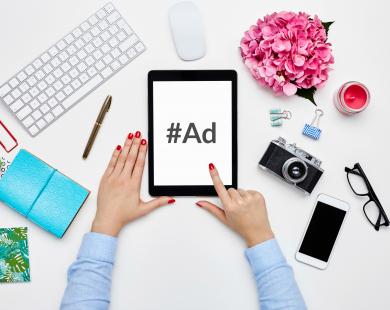7 Tips to Start Earning Money from Your Blog

Are you constantly reading stories about bloggers earning six-figures from their website and wondering when your first blogging penny is going to come in? Some bloggers go full-time within a year of launching, whilst others are plugging away at it in relative obscurity for years before they land their first paid gig.
How long it will take for you to begin earning a blogging income depends on many things such as your niche (it’s easier to stand out when you’re one of 100 bloggers on a topic, rather than one of 100,000), your number of readers and a dash of plain old luck, but there are steps you can take to speed the process up.
Remember that before anything else, you need to concentrate on creating great quality content and building an audience. Brands want to get something out of the partnership too so they’ll be looking at what you can offer them, as much as you’re considering what they can offer you. If you think you’ve got this step nailed, here are 7 tips on what to do next…
1. Start Using Affiliate Links
Affiliate programmes are one of the easiest ways to begin monetising your blog. Rather than needing to persuade brands to pay you up front, with affiliate marketing they only pay you once you’ve brought them a sale. This means they’re much more open to working with smaller and beginner bloggers.
According to an Optimus survey of 1,723 UK lifestyle bloggers, those writing about fashion earned an average of £1,116 per year from affiliate advertising. Starting out a brand’s affiliate can be a great way to prove to them that you can indeed turn your readers into their customers, and open a conversation about other types of paid collaboration.
Ready to get stuck in? Read our beginner guide to affiliate programmes for a more detailed introduction. Affiliate links aren’t just for your blog either – you can use them on social media sites, such as Pinterest, too!

2. Create a Media Kit
If you’re asking a brand to pay you money, it’s only normal that they’ll want some reassurance that it’s going to be money well spent – and by reassurance, we mean factual data. A media kit is the perfect way to gather all of this data up into one place.
Brands will typically want to know things like how big your audience is (e.g. how many visitors do you get per month?) and who those people are (is your audience mostly male or female? How old are they?). Google Analytics and the analytics provided by social media platforms such as Pinterest are the best places to start looking for this data.
Read our guide to creating a great media kit.
3. Get the Price Right
One of the most difficult things for beginners is knowing what to charge. We’ve written about how to come up with a sponsored post fee before, but essentially you need to work out a rate that is affordable for the brand whilst making sure you earn an hourly rate you’re happy with (remember to include the time that goes into promoting the post after it’s live). For things like social media updates and banner ads that only take a moment to publish, consider how many people they will be seen by and choose a price you think is fair.
If you’re getting lots of advertising enquiries but no purchases, that could be an indicator that your price is too high compared to other, similar bloggers and you may want to consider reducing it or running a temporary sale.

4. Don’t Forget to Contact Brands!
Don’t just pop a media kit on your blog and expect the advertising requests to start pouring in. If you’ve worked with brands in an unpaid capacity in the past, such as reviewing a product for them, drop them an email to say thanks again and let them know that you’re now offering advertising with a link to your media kit. You could also take a look at which brands have bought banner adverts or sponsored posts on blogs similar to yours.
Try not to make your first contact with a brand an ask for money though; brands are more likely to respond positively if they know you’re a genuine fan, and if they have some proof that working with you will send traffic their way because you’ve featured them on your blog before. Contact your favourite brands and ask to be added to their PR list – you’ll be kept up to date with their latest campaigns, and they’ll know that you exist.
5. Let an Agency Find Opportunities for You
Nervous about approaching brands? Not having much luck on your own? That’s where a third party can come in helpful. Larger brands in particular (the ones with bigger budgets!) are more likely to run their own campaigns with a group of bloggers all writing about the same topic, than to do isolated sponsored posts with whomever happened to contact them that month.
One such third party is us, CollectivEdge! *waves* We offer various opportunities including sponsored posts and sponsored social media updates. Fill in the form here to become a member (it’s free) and when one of the brands we’re working with runs a campaign that matches up with what you write about, we’ll contact you.

6. Sell to Your Readers
Brands aren’t the only ones with cash to spend – your readers are too! Perhaps you can create a product they’d be interested in – knitting or sewing patterns if you’re a craft blogger, for example.
You can also sell access to exclusive content. An eBook is a great way to do this and you can create one yourself – here’s why we love them, and here’s how to write and promote one.
7. Stay True to Your Blog
When you’re a newbie blogger and the advertising opportunities are few and far between, it can be tempting to accept all of them just to make a quick buck. However, an advert from a company that’s unrelated to the topics you usually cover will stick out like a sore thumb to your readers. Stay true to them and to yourself by only accepting collaborations from brands you actually like. You’ll build a more authentic voice, and in the long run, that’s the kind of thing that will lead to landing bigger and better brand deals!
We hope you’ve found this list useful. Don’t forget to check out these 10 things that could be putting brands off from working with you too.
How long have you been blogging for without earning money from it, or how long did it take you to get your first sponsored post or banner advert sale?





Leave a Reply